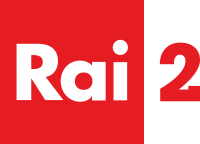Rai 2
Rai 2 (until May 2010 known as Rai Due) is the second public television channel broadcast by Italian state-owned broadcaster RAI. Rai 2 first started broadcasting on 4 November 1961. In the eighties it was known for its political affiliation to the Italian Socialist Party; in recent years it has shifted its focus towards the youth with the airing of talk shows, reality television, drama series, sitcoms and infotainment; its direct competitor to Mediaset's Italia 1.
| Rai 2 | |
|---|---|
 | |
| Launched | 4 November 1961 |
| Owned by | Rai |
| Picture format | 1080i HDTV (downscaled to 16:9 576i for the SDTV feed) |
| Audience share | 6.85% (May 2014, [1]) |
| Country | Italy |
| Language | Italian |
| Broadcast area | Italy |
| Headquarters | Rome, Italy |
| Formerly called | Secondo Programma (1961–1975) Rete 2 (1975–1983) Rai Due (1983–2010) |
| Sister channel(s) | Rai 1 Rai 3 Rai 4 Rai 5 Rai Gulp Rai Movie Rai News24 Rai Premium Rai Scuola Rai Sport Rai Storia Rai Yoyo Rai Ladinia Rai Südtirol Rai Italia |
| Website | rai |
Availability | |
| Terrestrial | |
| Digital terrestrial television | Channel 2 (SD) Channel 502 (HD) |
| Satellite | |
| Hot Bird 13°E (Europe, Middle East & North Africa) | 10992 V 27500 2/3 (SD) |
| Sky Italia | Channel 102 (SD) |
| Tivùsat | Channel 2 (SD) Channel 102 (HD) |
| NOVA Greece | Channel 855 |
| Cable | |
| MC Cable | Channel 202 |
| Com Hem | Channel 213 |
| Cablecom | Channel 94 Channel 203 |
| Numericable | Channel 77 |
| DNA Oy | Channel 376 |
| Ziggo (Netherlands) | TV Italiana Ziggo App Channel 3 |
| Kabel Deutschland (Germany) | Channel 867 (SD) |
| IPTV | |
| A1 TV (Austria) | Channel 201 (SD) |
| Telekom Entertain (Germany) | Channel 382 (SD) |
| Streaming media | |
| Rai.tv | Live Streaming |
The channel launched its own HD feed by late-September 2013 on pay television. The feed entered on DTT in September 2016.
Programmes
A few programmes include:
- TG2 (Newscast)
- Quelli che... il Calcio
- Castle
- Desperate Housewives
- ER
- Eurovision Song Contest (finals until 2015)
- Felicity
- JAG
- Las Vegas
- Law & Order
- Life on Mars
- NCIS
- NCIS: Los Angeles
- NCIS: New Orleans
- NUMB3RS
- Once Upon a Time
- Past Life
- Popular
- Primeval
- Starsky and Hutch
- S.W.A.T.
- MacGyver
- Bull
- Il collegio
- Pechino Express
Cartoons
- Digimon (2000-2013, now moved to Super!)
- The PowerPuff Girls
- Kid Paddle
- Ashita no Nadja
- Pretty Cure
- Teletubbies
- Monster Allergy
- Wunschpunsch
- Winx Club (2004-2014, now moved to Rai Gulp)
- Chaotic (Caiotici)
- NASCAR Racers (Gare Nascar)
- Inazuma Eleven
- Yo-Kai Watch (Le Avventure di Yo-Kai Watch)
- Franny's Feet
- Tokyo Mew Mew
- Spaced Out (Gli Astromartin)
- Robotboy
- Sammy & Co.
- Tom
- Scan2Go
- Wheel Squad
- Star Wars Resistance (upcoming)
- Alisa Knows What to Do! (upcoming)
- Code Lyoko (Note: did not air the second, third and fourth series)
Kids Block
- Random/ Cartoon Flakes (2005-2014)
- Go-Cart mattina (1997-2005)
Not longer aired programmes
Until 1975 regular broadcasting was monochrome, with very few exceptions. Since late 1975, then called Rete 2 began airing some new shows in colour, then beginning semi-regular colour broadcasting during the autumn season (a few hours a week). Rai 1 followed its "sister network" a few months later. Eventually, regular broadcasting in colour began on 1 February 1977.
- Rischiatutto, one-hour-long Italian version of Jeopardy!, hosted by Mike Bongiorno, aired on Thursday night, from 5 February 1970, at 9:15 PM (in 1972 season at 9:30 PM). About 20 million viewers watched every episode of the show,[2] the first one aired on Rai 2 to enter in the list of the Ten Most Watched Programmes on Italian TV during the year. The final two seasons (1973 and 1974) were aired on Rai 1.
- Ondalibera (known popularly as Televacca, Cow TV), was a one-hour-long comedy and satirical show hosted by a very young Roberto Benigni in his television debut. In the show, the Tuscan peasant Mario Cioni (Benigni) hosts a programme aired in the fictional local channel Televacca, which has its headquarters in a stable full of hay and animals. Using a sometimes vulgar and desecrating speech, with a heavy Tuscan accent, Benigni improvised monologues and satirised the TV medium and the society. Co-hosts were the boor Monna (Carlo Monni) and his "daughter" Donatella, a Daisy Mae Yokum stylish young woman.[3] Considered one of the most controversial programmes in Italian TV history, censored and interrupted after only four episodes despite being relatively successful, the programme debuted on 19 December 1976, airing on Sunday nights at 8:45 PM.[4]
References
- "Sintesi Mensile 1A" (PDF). Auditel. Retrieved 30 June 2014.
- http://www.eurojump.com/content/ventimilioni-il-gioved%C3%AC-di-mike%5B%5D (Italian)
- https://www.youtube.com/watch?v=DnBmyzkAPHQ
- https://www.youtube.com/watch?v=Knc8aUslmDw The "opening theme" of the show, titled "La Marcia degli Incazzati" (Pissed Off Guys' March)
External links
- Official Website (in Italian)